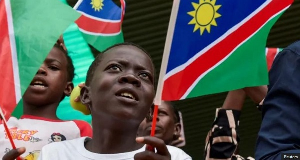A Research article by the Institute for Energy Security (IES) has made a case for the strong consideration of Solar and Wind energy sources in Ghana and Africa’s post-COVID recovery plan.
In an article authored by IES Research and policy Analyst Raymond Nuworkpor citing multiple authorities, The IES said not only does the adoption reduce pressure on the national grid because of “its unreliability in terms of power supply”, but “provides cheaper sources of energy at more stable generation and use levels, that enable businesses to adequately plan and grow.”
The institute added further: “The green energy sources are rapidly becoming cheaper than fossil fuel powered plants. 56 percent of capacity additions for utility-scale renewable power in 2019 achieved lower electricity costs than cheapest coal plants. There will also be 23 billion annual potential savings if the costliest 500 GW of existing coal were replaced by solar and wind. Also, 1.8 gigatons of carbon dioxide reduction annually possible, equalling to 5 percent of the total global carbon dioxide emissions last year. And lastly, a cumulative global GDP will grow by US$98 trillion, according to IRENA.”
Find the full article below:
During the first quarter of 2020, the world recorded slumps in prices of crude oil, exposing its vulnerability and volatility. Due to the coronavirus (COVID-19), crude oil prices plunged by 54.18 percent on average terms, starting the year on a high of US$66.74 to close the first quarter of 2020 at US$30.58 per barrel. The price plummet was so precipitous that at a point, a barrel of crude cost less than a meal at any fast food restaurant. The suspension of exploratory works, slashing of projected crude oil receipts, job losses, diversification of investment from fossil fuel, withholding of shareholders’ returns, filing of bankruptcy et cetera were the dominant features of the crude market in the first and second quarter of year 2020.
COVID-19 has changed the world as we know it. The pandemic has changed among others, the way we eat, the way we work, the way we communicate. In International Energy Agency’s report, “World Energy Investment” published in May 2020, the agency describes drastic changes in the energy markets in the wake of the pandemic. The report reveals the largest fall in energy sector investment ever and uncovers historic shift along the way. It shows that for the first time ever, there will be more spending on electricity than on oil. Most importantly, the report asserts that it is in the power sector where the possibilities of transition to a low-carbon energy sector are most apparent.
Although a separate report from the IEA noted that, newly installed renewable power capacity was expected to decline by 13 percent this year, the renewable (green) energy sector was proven to be disproportionately resilient to the impacts of the pandemic.
Damilola Ogunbiyi, Chief Executive Officer (CEO) and Special Representative of the United Nation (UN) Secretary-General for Sustainable Energy for All (SE4ALL) and Co-Chair of UN-Energy, has noted that, “as countries rebuild economies from the impacts of the pandemic, they are faced with a unique once-in-a-generation opportunity to recover better with sustainable energy.”
It will therefore not be shocking that the post-COVID-19 era will be jam-packed with sustainable energy related programmes, and laggard governments that are slow to adopt and advance their renewable energy resources, risk being left behind – or worse, will completely be shut out. They will suffer consequences such as slow social and economic development, augmented environmental problems resulting from continued reliance on fossil fuel energy resources.
The Renewable Agenda
Energy related matters, particularly the production of electricity from renewable sources, are critical on the agendas of most governments around the world today. The United Nations’ Millennium Development Goals (MDGs), the Sustainable Development Goals (SDG 7- Access to affordable, reliable, sustainable and modern energy for all by 2030) and the Paris Agreement, emphasize the importance of energy sustainability, healthy ecosystem and decarbonisation.
The UN Secretary-General’s SE4ALL initiative, clearly shows how clean, affordable and safe energy can enable countries recuperate better and leverage renewable energy to not only close the energy gap but also reset their economies. The SE4ALL guide shows that African countries, through a widespread, ambitious and genuine commitment to advancing comprehensive renewable energy can achieve resilient economies with long-term growth, new jobs, cleaner and healthier environments, increased Gross Domestic Product (GDP), improved agriculture yields, and affordable and sustainable energy for all in the long term.
It is an important fact that developing renewable energy is a must-have, a make-or-break commodity. Hence, most governments have already planned and are deploying strategies to achieve sustainable energy supply. Many countries around the world have instituted objectives to adopt and utilize renewable energy resources to shore up their power generation and consumption. By the adoption of policies and pursuance of targets, countries like China, United States (USA), Germany, United Kingdom (UK), Saudi Arabia, and the United Arab Emirates (UAE) have become world leaders in renewable energy, and are investing heavily into renewable energy technologies (RETs).
Germany for instance, continue to play a key role in the energy transition conversation, investing heavily in technology, education and research.
Germany has set for itself a 65 percent target by 2030, requiring an increase in wind and solar generation capacity to between 215 and 237 gigawatts (GW) from 120 GW presently. Wind, solar and other clean energy sources currently account for more about 40 percent of the country’s energy production, having more than doubled over the past 8 years, according to Reuters. The International Renewable Energy Agency (IRENA) figures for 2018 show around 284,000 people working in Germany’s renewable energy sector, the vast majority in wind energy.
The African Story
The story in Africa, especially sub-Saharan Africa looks different, yet promising. A crucial source of concern is the worrying trend of lack of access to affordable electricity and the unsteady nature of electricity supply; factors which have been impediments to continental development and energy security.
Isn’t it mind boggling that till date Africa, a continent with the richest solar resources in the world, has installed only 5 gigawatts (GW) of solar photovoltaic (PV), which is less than 1 percent of the global total, as noted by the International Energy Agency (IEA). Meanwhile, the agency projects that Sub-Saharan African countries are to witness the fastest growth from 2020 to 2040, with demand for electricity doubling to over 1,600 terawatts-hour (TWh).
Morocco remains the leading country playing an important role in Africa’s energy transition with the Noor Ouarzazate solar complex, according to a June report by the African Development Bank (AfDB) Group. The country is making strides to address Africa’s energy infrastructure deficit challenge. The June 2020 Climate Action Tracker statistics, founds Morocco and the Gambia as the only countries in the world on track to curb emissions to the 1.5°C limit urged by Paris Agreement and the UN’s Intergovernmental Panel on Climate Change (IPCC).
In Ghana, businesses production and outputs over the years have been affected in one way or the other, due to inadequate power supply or power fluctuations. It is reported by the Institute of Statistical, Social and Economic Research (ISSER) of the University of Ghana that Ghana’s power crisis of 2012-2015 had a huge negative effect on manufacturing firms, which includes the fold up of businesses and job loss. It is for such reasons that a push for the utilization of renewable sources of energy is in the right direction. Not only does this take pressure off the national grid with its unreliable power supply, but also provides cheaper sources of energy at more stable generation and use levels, that enable businesses to adequately plan and grow. Africa and for that matter Ghana, stands to potentially benefit immensely with its small and medium scale enterprises, households et cetera, as they explore and utilize available sources of renewable energy to cut down on their energy expenditure.
Adoption and Benefits
According to International Renewable Energy Agency (IRENA), jobs in renewables would reach 42 million globally by 2050; additional 21 million jobs through energy efficiency measures and 15 million jobs through system flexibility. The green energy sources are rapidly becoming cheaper than fossil fuel powered plants. 56 percent of capacity additions for utility-scale renewable power in 2019 achieved lower electricity costs than cheapest coal plants. There will also be 23 billion annual potential savings if the costliest 500 GW of existing coal were replaced by solar and wind. Also, 1.8 gigatons of carbon dioxide reduction annually possible, equalling to 5 percent of the total global carbon dioxide emissions last year. And lastly, a cumulative global GDP will grow by US$98 trillion, according to IRENA.
Power generation cost by wind energy for instance continue to rapidly plummet over the last decade per data gathered by IRENA. Onshore and offshore wind declined by 39 percent and 29 percent respectively. The declining cost of wind energy makes it cost effective and prudent investment, with the same amount of money, investment value increases i.e. US$1 million invested 2010 yields 514 kilowatts (Kw), the value however increases to 679 kW in 2019 for onshore wind.
With the lowering cost of renewable energy sources, renewable has demonstrated its robustness, stability, sustainability, and cost effectiveness over this malignant Covid-19 period unlike the crude oil market. The shift from a hydrocarbon based energy production to renewable energy sources is pushing lot of investors, fund managers, and oil majors to diversifying capital into renewable energy sources.
The sustainable recovery strategy by countries around the world especially Africa must be to protect existing renewables project while erecting the needed enablers to upscale infrastructure related to energy transition.
Securing strategic funding for local industries and institutions for a smooth transition from hydrocarbon based sources to renewables for an inclusive growth and development, is something that cannot be overlooked.
The energy transition conversation must be a global dialogue, with Africa as an active participant because of the enormous job opportunities associated with renewable energy production, i.e. drastic reduction in electricity tariffs, decarbonisation and minimization of climate change related disasters. The renewable energy conversation does not mean pulling the plug on fossil fuel overnight but rather providing the needed catalyst to ensure adequate energy mix especially in Africa with it attended electricity challenges.
It is the resilience of renewable to the COVID-19 pandemic, combined with the falling cost of power generation from renewable energy resources that has led many to forecast a significant increase in green investment post-COVID-19, and Africa cannot miss out of this opportunity. There is a strong consensus that renewable energy is the future emerging segment for the energy industry, an opportunity for also green investors to acquire shares at cheaper prices.
Business News of Thursday, 16 July 2020
Source: Institute for Energy Security

















